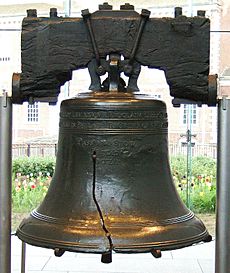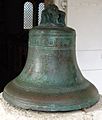Whitechapel Bell Foundry facts for kids
The Whitechapel Bell Foundry was a very old business in London. It was located in an area called Whitechapel. When it closed, it was the oldest company in Great Britain that made things. This bell foundry mainly made church bells and all the parts needed for them. It also made single bells for tolling, carillon bells (which are like musical instruments), and handbells. The foundry is famous for making the original Liberty Bell. This bell is a well-known symbol of American independence. They also re-cast Big Ben, the huge bell that rings from the Elizabeth Tower at the Houses of Parliament in London.
The Whitechapel building is a special historic place, known as a Grade II* listed building. The foundry closed on June 12, 2017. It had been making bells for almost 450 years and was at its Whitechapel location for 250 years. The very last bell they made was given to the Museum of London. Other tools used for making bells were also given to the museum. The building itself has been sold.
After the Whitechapel Bell Foundry was sold, the rights to make bells were bought by a company called Whites of Appleton in Oxfordshire. This company had worked with the foundry for 197 years. Now, the rights to make large tower bells belong to Westley Group Ltd. However, smaller presentation bells and handbells are still made under the name Bells of Whitechapel Ltd.
Contents
History of the Bell Foundry
The Whitechapel Bell Foundry company started way back in 1570. The last building they used, at 32–34 Whitechapel Road, was built in 1670. It used to be an old inn called "The Artichoke." This inn was damaged in the Great Fire of London. The Artichoke closed in 1738, and the Whitechapel Bell Foundry moved into the building the next year. The foundry stayed there until May 2017.
It was one of only two bell foundries left in the UK. It had been making bells without stopping for almost 450 years. However, the expert bell makers of Aldgate and Whitechapel can be traced back even further, to 1420. The special mark of three bells can be seen on the bells they made. A sign with three bells also hung over the door of the Whitechapel site. The previous owners, Alan and Kathryn Hughes, said the foundry was a family-owned business for its whole history. Alan Hughes's grandfather bought the company in 1904, and it stayed in the family until it was sold in 2017.
How the Foundry Adapted Over Time
The business had to change over the centuries to keep going. In more recent times, fewer new churches were being built. So, the foundry started making more handbells and doorbells. They saw a big increase in orders for table bells. This happened after the TV show Downton Abbey became popular. About one-third of their sales went to other countries.
In 2013, the foundry started an online shop. They sold house bells, musical instruments, and special personalized items. The business of making large bells was not much affected by tough financial times. This is partly because it took a very long time, about 11 years, from when someone asked for a bell to when it was finished.
During World War II, the foundry helped the war effort. They made metal casings for the War Office. Alan Hughes, a former owner, said that the government guaranteed orders and good prices. They also paid quickly, which was not always the case with other customers. The foundry was very busy after the war. They replaced bells that were lost or damaged by fire during bombing raids across London. Hughes explained that their business often did well when the national economy was struggling. He said that one year was their busiest in thirty years. He also shared a story about an order from the 1890s that was finally completed in 1998.
Efforts to Preserve the Building
In March 2017, several groups that protect old buildings tried to get the foundry's building listed as a Grade I historic site. This would have given it even more protection. They wanted to keep the building important to the local community. These groups included Save Britain's Heritage and the Royal Academy of Arts.
The foundry was sold to a US investor named Raycliff. They planned to turn the back of the building into a hotel with 100 to 108 rooms. They also wanted a bell-themed cafe. However, they said they would keep space for making smaller bells. The plan has the support of Historic England. But the idea has caused some debate. The government decided to review the plan on January 22, 2020. This stopped the London Borough of Tower Hamlets from approving the building plans.
Famous Bells Made Here
Many churches around the world have bells made by the Whitechapel Bell Foundry. But its two most famous bells are not in churches. In 1752, the foundry, then called Lester and Pack, made the Liberty Bell. This bell was ordered to celebrate 50 years since William Penn's 1701 Charter of Privileges. This was Pennsylvania's original constitution. The bell cracked when it was first rung because it was damaged during its journey across the Atlantic Ocean. After many repairs, it cracked again in 1846. This happened when it was rung to celebrate George Washington's birthday. Since 2003, the bell has been kept at the Liberty Bell Center. This center is near Independence Hall.
Big Ben is the huge bell that rings every hour at the Palace of Westminster. It was made in 1858 and first rang on May 31, 1859. "Big Ben" weighs about 13.5 tons. It is the largest bell ever made at the foundry. This bell also cracked because the hammer used to strike it was too heavy at first. The crack and later adjustments give Big Ben its unique sound today. A metal outline of Big Ben is around the entrance door of the Whitechapel Foundry. The original tool used to shape Big Ben is kept near the furnaces. The final cost for Big Ben was £572.
Bells in Cathedrals and Churches
Whitechapel made bells for several large cathedrals. Guildford Cathedral in Surrey had a set of 10 bells, which later became 12. Canterbury Cathedral added more bells in 1981, making a set of 14. The National Cathedral in Washington, D.C. got its bells in 1962. The foundry also made "Great Tom" for Lincoln Cathedral. They made the "Clock Bells" at St Paul's Cathedral and the bells of Westminster Abbey.
Between 1924 and 1942, the foundry made 14 bells for the Liverpool Cathedral. All these bells have parts of psalms engraved on them. These bells are known for being the heaviest set of change ringing bells in the world. The bell founder at that time, Albert Hughes, is remembered in a stained glass window in the church.
Churches with Whitechapel bells are found all over. Some are as close as St Mary-le-Bow, Cheapside in London. Others are as far away as the Armenian Church, Chennai, in India. English examples include St Dunstan's, Stepney and St Dunstan's, Mayfield. Also, St Michael's, Beckwithshaw, St Mary-le-More, Wallingford, Church of St Thomas the Apostle, Killinghall, and St Michael and All Angels, Leaden Roding. In America, there is St. Michael's Church in Charleston, South Carolina. Australian churches include St Bartholomew's Church, Burnley, St Stephen's Anglican Church in Newtown, St Philip's Church, and St James' Church, Sydney.
Other Important Bells
Some bells not in churches are in public places like clock towers. Thomas Mears II made the bell for Herne Bay Clock Tower in 1837. The Old Post Office in Washington, D.C., USA, has 10 bells. These bells were made by the Whitechapel Foundry in 1976. They were installed in 1982 and officially dedicated in 1983. The bells weigh from 581 to 2953 pounds. These bells, called The Congress Bells, were a gift from Britain to the US Congress. They celebrated 200 years of American independence.
After the September 11 attacks in the United States in 2001, the company made a special bell. It was called the Bell of Hope. It was a gift from the people of London to New York City. It is rung at 8:46 AM every year on the anniversary of the tragedy. This is the time the first plane hit the first tower. The bell was designed by architect Paul Byard. It was first rung in America by the Bishop of New York, Mark S. Sisk. The bell was at Trinity Church (Manhattan) before moving to St. Paul's Chapel. In 2005, it was rung four more times for the people killed in the 7 July 2005 London bombings.

The Whitechapel Bell Foundry designed the Olympic Bell. This bell was seen at the opening ceremony for the London 2012 Olympic Games. However, it was not actually made at the foundry. The furnaces at Whitechapel could not melt enough metal for the 23-ton bell. So, it was made at a factory in the Netherlands that usually makes ship propellers. The Olympic bell has the lowest sound of any bell in the world. It is also the largest bell in the world that is tuned to a musical note. It is the widest bell in Britain. It now hangs in the Queen Elizabeth Park. It is not rung because it is considered too loud for people living nearby.
The foundry also made the Royal Jubilee Bells. These bells were used on the main boat for the Thames Diamond Jubilee Pageant in the same summer. They now hang in the church of St James Garlickhythe.
The musician Damon Albarn had three bells made by the foundry. These were for the song "On Melancholy Hill" on the Gorillaz album Plastic Beach. They were tuned to the notes D, A, and C-sharp. However, they were not used in the final song. But one of the bells is often used when the band plays "We Got the Power" live.
The very last bell made at the foundry was on March 22, 2017. This bell was given to the Museum of London. Historical items from the building were also given to the museum. The rights to make Whitechapel bells were sold to Whites of Appleton in Oxfordshire. This company had worked with the foundry for 197 years.
Master Founders of Whitechapel
The names on this list are the people whose names are cast into the bells from Whitechapel at different times. Before Robert Mot in 1574, the mark of three bells was often used. This showed that the bell was from Whitechapel (or Aldgate).
|
|
Images for kids
-
The Jessen Bell (1814), St. John's Anglican Church (Lunenburg), Nova Scotia, Canada
-
The bells of St Bees Priory shown in the "up" position. Cast by Charles & George Mears in 1857
-
Template for Big Ben which hangs at the foundry
-
Guildford Cathedral bell cast at Whitechapel
















